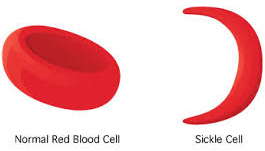Science > Biology > Human Anatomy and Physiology > Cardiovascular System > Disorder Associated With RBCs Anaemia (Anemia)
Anaemia or Anemia is defined as a decrease in the ability of the blood to carry oxygen due to (1) a decrease in the total number of erythrocytes, each having a normal quantity of hemoglobin, or (2) a diminished concentration of hemoglobin per erythrocyte, or (3) a combination of both. It decreases the oxygen-carrying capacity of the blood.
Causes of Anaemia:
- Dietary deficiencies of iron (iron-deficiency anaemia), vitamin B12, or folic acid
- Bone marrow failure due to toxic drugs or cancer
- Blood loss from the body (hemorrhage) due to severe injury leading to iron deficiency
- Inadequate secretion of erythropoietin in kidney disease
- Excessive destruction of erythrocytes (for example, sickle cell anaemia)
Symptoms of anaemia:
The symptoms include fatigue, weakness, pale or yellowish skin, irregular heartbeats, shortness of breath, headaches, dizziness, lightheadedness, chest pain, cold hands and feet.
Types of anemia:
Iron deficiency anemia.
This most common type of anemia is caused by a shortage of iron in the body. Iron is very important in the production of haemoglobin which is an oxygen carrier. It is caused by blood loss, such as from heavy menstrual bleeding or severe injury, an ulcer, cancer and regular use of some pain relievers, which can cause inflammation of the stomach lining resulting in blood loss. The iron lost from the body must be replaced. Due to non-adequate iron in bone marrow, the body can’t produce enough hemoglobin for red blood cells. This type of anemia is observed in pregnant women.
Treatment of iron deficiency anaemia usually involves taking iron supplements and making changes in diet. This iron lost from the body must be replaced by the ingestion of iron-containing foods like meat, liver, shellfish, egg yolk, beans, nuts, and cereals.
Vitamin deficiency or pernicious anemia:
Production of normal erythrocyte numbers requires an extremely small amount of a cobalt-containing molecule, vitamin B12 (also called cobalamin). It is required for the action of folic acid. There are some people who consume enough B-12 aren’t able to absorb the vitamin. A diet lacking in these and other key nutrients can cause decreased red blood cell production. This leads to vitamin deficiency anemia. It is easy to treat with vitamin B12 shots (injections) given in a muscle periodically or pills.
Anemia of inflammation:
Anemia of inflammation, also called anemia of chronic disease or ACD, is a type of anemia that affects people who have conditions that cause inflammation. Inflammation may prevent the body from using stored iron to make enough healthy red blood cells, leading to anemia. Certain diseases like cancer, HIV/AIDS, rheumatoid arthritis, kidney disease, Crohn’s disease, and other acute or chronic inflammatory diseases can interfere with the production of red blood cells. It is the second most common type of anemia, after iron-deficiency anemia.
A health care professional may prescribe the erythropoiesis-stimulating agents (ESAs) epoetin alpha darbepoetin alpha to treat anemia related to CKD, chemotherapy treatments for cancer, or certain treatments for HIV.
Aplastic anemia:
Aplastic anemia occurs because of damage to stem cells inside the bone marrow. As a result, the bone marrow makes fewer red blood cells, white blood cells, and platelets. This rare, life-threatening anemia occurs when the bone marrow doesn’t produce enough red blood cells. Its causes include infections, certain medicines, autoimmune diseases and exposure to toxic chemicals.
Treatments may include medicines to suppress the immune system, blood transfusions, or a blood and bone marrow transplant.
Anemias associated with bone marrow disease:
Bone marrow disease (bone cancer), may be the result of a malignant tumor of the bone or cancer that has spread, or metastasized, from another area of the body to the bone. Bone cancer can destroy bone marrow tissue and the body’s ability to manufacture red blood cells, thereby causing anemia. A variety of diseases, such as leukemia and myelofibrosis, can cause it by affecting blood production in the bone marrow. The effects of these types of cancer and cancer-like disorders vary from mild to life-threatening.
Supportive care is usually the first line of treatment for bone marrow disease anemia, and this care relieves symptoms but does not cure the disease. Supportive care includes blood transfusions, platelet transfusions, iron, and folic acid supplements, growth factor drugs such as epoetin alfa (Procrit), Following strict infection prevention procedures.
Hemolytic anemias:
Certain blood diseases increase red blood cell destruction. this type can be inherited or can develop it later in life.
Its main cause in the rapid destruction of RBCs. The life span of red blood cells is 120 days. Red blood cells develop in the bone marrow (hemopesis) are destroyed in the spleen (hemolysis). Thus red blood cells in the body are destroyed faster than bone marrow can replace them.
Treatments may include lifestyle changes, medicines, blood transfusions, blood and bone marrow transplants, or surgery to remove the spleen.
Sickle Cell Anaemia:
Sickle cell anemia is an inherited form (a genetic disorder) of hemolytic anemia. It is caused by a defective form of hemoglobin that forces red blood cells to assume an abnormal crescent (sickle) shape. These irregular blood cells die prematurely, resulting in a chronic shortage of red blood cells.

There’s no cure for most people for this disorder. But treatments can relieve pain and help prevent problems associated with the disease. Bone marrow transplant, also known as stem cell transplant, offers the only potential cure for it.